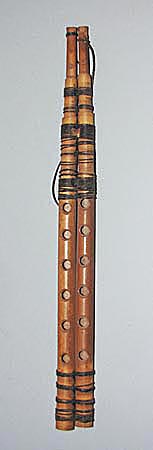
Owner: HWMC
Catalog#: ME-AERV-04-14
Reedpipes
Egypt 'Midjweh' (Mijwiz-A)
Egypt and Levant (Western Asia)
Egyptian
Bamboo, fiber string
Mid-20th Century
Length: 11.5 in; Width: 1.25 in; Diameter/depth: 0.5 in
Aerophones – Wind Instruments Proper – Reedpipes
The midjwiz is a double-pipe clarinet (single-reed on each pipe) that is bound together by string; has a cylindrical bore; and is made from bamboo. The word midjwiz means ‘dual’ in Arabic and it belongs to the family of idioglot clarinets which date at least to the 1580-1090 B.C.E. It is the ancestor to the bagpipes, clarinets, etc.
This double clarinet-type instrument has two pipes of equal length with six small holes in each pipe for the fingers. Two smaller and shorter reed tubes are cut at the nodes and a single cut is made into each of these to create the vibrating reeds. These are then inserted into the ends of the two pipes. When played, the entire vibrating reed tubes are inserted into the mouth. It requires a special playing technique called ‘circular breathing’ that allows it to produce a continuous tone without silences for taking in air. The midjwiz is still a popular instrument in the Middle East region of Levant (Eastern Mediterranean, and northeast Africa, including Palestine, Lebanon, Syria, and Jordan), where it accompanies belly dancing and folkloric line dancing.
The mijwiz is also related to the double pipe arghul, which consists of one short pipe with five to six holes (melody) and a longer pipe with no finger holes (drone).
